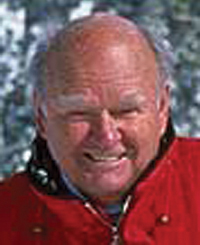It's that time of the year when I finally get to clean out the drawers and closet in my office.
As I look out of my office window, it just looks cold. The thermometer says 6 below zero here in Montana. If you are from California, that's real cold, but if you are from Minneapolis, 6 below zero is almost shirt-sleeve weather.
I turned to some old photographs that have absolutely no value to anyone in the world except to trigger memories of where my filming career started. One of them is of a 1950 Chevy panel delivery truck in a snow bank behind the Squaw Valley Lodge, which burned to the ground a year or two later. This panel truck was my home for several years as I traveled and made my first four feature-length ski films.
It was the ideal set up: no large overhead to apply against earnings when I started selling $1 tickets to the next new ski film the following October. My only overhead was gasoline, an occasional oil change and groceries. Hidden in the back of my truck was a complete bachelor apartment. I had a very comfortable bed, a Coleman stove and all the cabinet space I needed for food, clothes, camera equipment, a portable typewriter, a movie projector and a screen. It also held the hat that I passed at screenings in the hope that I could get enough money to buy gas to get to the next resort and to buy more film.
1950 was full of wonderful, exciting, pioneering times.
And darn cold times too.
It was as cold inside the truck as outside. Still, getting up in the morning was a lot easier than when I lived in the small trailer in several ski resort parking lots for two winters. I designed and built the mobile apartment so I could just sit up in bed in my sleeping bag, pump up the Coleman stove, light it and in a few minutes the frost inside the truck would start melting. Within about 10 minutes the truck was toasty warm, and my ski boots that were in a rack in the ceiling would be warm enough to start thinking about putting them on.
In the meantime the water was boiling for the oatmeal, the milk was being thawed out, and I was more than comfortable—except for the fact that the temperature gradient from the floor to the ceiling ranged from about zero to as high as 110 degrees Fahrenheit.
Now the real job began as I would try and talk the owners of whatever resort I had parked in the night before out of a free lift ticket. I had a semi-refined sales pitch about how many times I would show their resort in the fall of 1951 and how I could make their ski school director world famous. Well, at least famous in whatever ski club I could talk into sponsoring my newest film.
In those days, the ski school director was almost always the best skier on the hill, and since there were less than 15 chairlifts in America in those days, it wasn't too hard to make someone famous in such small a market as skiing was.
I had a small rucksack that held my hand-wind camera, half a dozen 100-foot rolls of 16 mm film, boundless enthusiasm and an extra peanut butter sandwich for lunch. No one ever told me that I should be cold and tired because I was living in a truck.
And here I am, almost 60 years later sitting at a word processor and cleaning out an office full of stuff that wasn't even invented then.
Back in 1951 it would be 15 years before Johnny Carson would appear on late night television, President Truman was wrestling with the Korean War, I had done my tour of duty in the Navy during World War II and President Bill Clinton was 3 years old. Today he's 4.
But back to filming while living in the back of a truck in Squaw Valley in 1951.
At that time they only had one chairlift, two rope tows and half a dozen ski instructors. Skiing was already underway in a big way in California. This brought the number of chairlifts in the state to three. That's right, three chair lifts in California. And I was lucky enough to have already ridden and filmed every one of them.
When you lived in a truck, showering was a problem, but I solved that by simply using the shower of one of my old ski instructor friends who still had a job there.
Occasionally, I even managed to have a road-kill dinner party in the truck that would comfortably seat four people; six uncomfortably.
The parking lots that I stayed in the most that winter were at Mammoth. It was a seven-hour drive from Redondo Beach without a single mile of freeway, but it worked out fine. I would supply the truck and four or five of my friends would buy the gas. My passengers and I would take turns at piloting the truck for the seven-hour drive. I always drove the first hour so I could sleep most of the way. When we finally got to Mammoth at 2 or 3 a.m., we would park in the campground. I would just stay asleep in the bed in my truck and my four or five passengers would sleep outside.
I managed to convince Dave and Roma McCoy that "yes, I was a ski motion picture maker," and so Dave would ski for me in his T-shirt in between hauling cans of gasoline up one of his two rope tows.
It was great to make and film turns then, and it's great to make turns today.






































